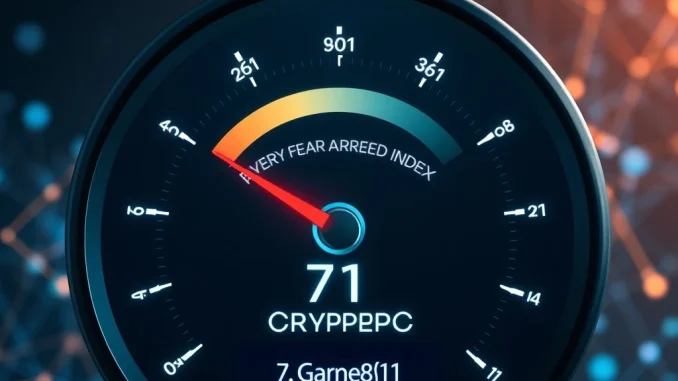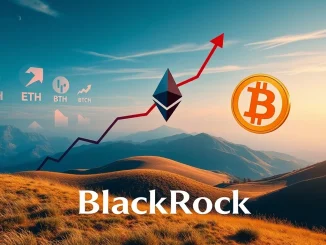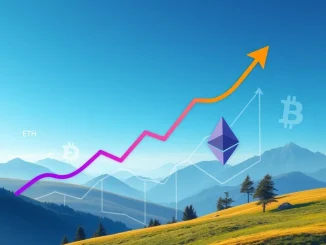
Ever wondered what truly drives the ups and downs of the volatile cryptocurrency market? While price charts tell one story, the underlying emotions of investors often tell another. This is where the Crypto Fear & Greed Index steps in, offering a fascinating snapshot of the prevailing sentiment. As of July 18, this crucial barometer, provided by software development platform Alternative, registered at 73. While this marks a minor dip of one point from the previous day, it firmly keeps the market rooted in the ‘Greed’ zone. But what does this really mean for you, the crypto enthusiast or investor?
Understanding the Crypto Fear & Greed Index: A Crucial Barometer
The Crypto Fear & Greed Index isn’t just a random number; it’s a sophisticated tool designed to distill complex market emotions into a single, digestible score. Ranging from 0 to 100, it paints a clear picture: 0 screams ‘extreme fear,’ signaling panic and potential buying opportunities, while 100 shouts ‘extreme greed,’ often hinting at an overheated market ripe for correction. Think of it as a psychological compass for the crypto landscape.
Why is this index so important? Because human emotions are powerful drivers in financial markets. Fear can lead to irrational selling, while greed can fuel speculative buying. By quantifying these emotions, the index provides a counter-perspective to pure price action, helping investors make more informed decisions rather than being swept away by the prevailing mood.
What Drives Crypto Market Sentiment? Unpacking the Six Factors
The index’s strength lies in its multi-faceted approach, combining six distinct factors to paint a comprehensive picture of crypto market sentiment. Each factor contributes a specific weight, ensuring a balanced assessment. Let’s break them down:
| Factor | Weight | What it Measures | Why it Matters |
|---|---|---|---|
| Volatility | 25% | Current volatility and maximum drawdowns of Bitcoin compared to average values over 30 and 90 days. | High volatility often indicates a fearful or uncertain market. Rapid price swings can deter new investors and trigger panic selling. |
| Market Momentum/Volume | 25% | Current volume and market momentum compared to average values over 30 and 90 days. | High buying volumes in a positive market often signal greed, while low volumes or selling pressure suggest fear. It shows conviction behind price movements. |
| Social Media | 15% | Analysis of keywords on Twitter (hashtags, mentions) to gauge public sentiment and engagement. | A surge in positive, hyped-up mentions can indicate widespread optimism and potential greed, whereas negative discussions suggest fear. |
| Surveys | 15% | Weekly polls asking people how they see the market. (Currently paused) | Directly measures investor sentiment through opinion polls, offering a raw snapshot of individual perceptions. (Note: This component is currently paused.) |
| Bitcoin Dominance | 10% | Bitcoin’s share of the total cryptocurrency market cap. | Rising Bitcoin dominance often indicates a flight to safety (fear) as investors move from altcoins to BTC, while falling dominance can signal increasing risk appetite (greed) as altcoins gain traction. |
| Google Trends | 10% | Analysis of search queries for crypto-related terms to gauge public interest. | A sudden spike in searches for terms like “Bitcoin price manipulation” or “crypto bubble” can indicate fear, while terms like “buy Bitcoin” or “crypto boom” might suggest greed. |
The current reading of 73, firmly in the ‘Greed’ zone, suggests that despite a slight pull-back, the collective mood remains optimistic. This is often driven by sustained positive market momentum and robust trading volumes, indicating strong buying interest that outweighs any minor bearish signals.
The Significance of Bitcoin Dominance in Market Sentiment
While the index considers the broader crypto market, Bitcoin dominance plays a crucial, albeit smaller, role. Bitcoin, as the flagship cryptocurrency, often acts as the bellwether for the entire market. When Bitcoin’s dominance rises, it often suggests that investors are consolidating their holdings into the most established and perceived ‘safest’ asset during times of uncertainty. Conversely, when its dominance falls, it can indicate that investors are feeling more confident, venturing into altcoins for potentially higher returns – a classic sign of increasing risk appetite and, you guessed it, greed.
The index’s slight dip from 74 to 73, while maintaining a ‘Greed’ status, could be a subtle nod to minor shifts in these underlying factors. Perhaps a slight increase in volatility, or a minor rebalancing of Bitcoin dominance, contributed to this marginal adjustment without fundamentally altering the overall optimistic outlook.
Navigating Market Momentum: When ‘Greed’ Becomes a Warning
The persistent ‘Greed’ reading, especially when high, often prompts a critical question: is this sustainable? While a bullish market is exciting, sustained market momentum driven by unchecked optimism can lead to an overheated environment. Historically, periods of extreme greed have preceded significant market corrections. It’s a classic paradox: everyone feels good, but that collective euphoria can blind investors to potential risks.
For savvy investors, a high ‘Greed’ score isn’t necessarily a signal to sell everything, but rather a prompt for caution and strategic planning. It encourages a review of risk exposure, profit-taking strategies, and perhaps a diversification of portfolios. It’s about being prepared, not panicked.
Insights from Extreme Greed: What Does 73 Really Mean?
A score of 73 is certainly high, bordering on extreme greed. While not yet in the ‘Extreme Greed’ category (80-100), it’s close enough to warrant attention. This level suggests that:
- FOMO is prevalent: Many investors are likely buying due to a fear of missing out on further gains.
- High valuations: Assets might be trading at prices that are difficult to justify based on fundamental metrics alone.
- Increased risk appetite: Investors are more willing to take on higher risks in pursuit of quick profits.
- Potential for correction: While not imminent, the higher the ‘Greed’ score, the more susceptible the market becomes to a sudden downturn.
It’s a powerful reminder that while positive sentiment can fuel rallies, it also elevates the potential for a sharp reversal. The slight dip from 74 to 73, though small, might indicate a minor psychological shift or a momentary pause in the relentless pursuit of gains, suggesting that some market participants are starting to exercise a tiny bit of caution.
Conclusion: Riding the Waves of Crypto Sentiment Wisely
The Crypto Fear & Greed Index serves as an invaluable tool for understanding the emotional undercurrents of the crypto market. Its current standing at 73, firmly in the ‘Greed’ zone, reflects a prevailing optimistic sentiment driven by strong market momentum and volume, despite a minor dip. While this indicates a buoyant market, it also underscores the importance of vigilance. Using this index as a contra-indicator – buying when others are fearful, and being cautious when others are greedy – can be a powerful strategy. Remember, in the dynamic world of crypto, understanding human emotion is just as crucial as analyzing charts and data. Stay informed, stay strategic, and navigate the waves of sentiment with wisdom.
Frequently Asked Questions (FAQs)
Q1: What is the Crypto Fear & Greed Index?
The Crypto Fear & Greed Index is a tool that measures the current sentiment of the cryptocurrency market, ranging from 0 (extreme fear) to 100 (extreme greed). It helps investors understand if the market is overly emotional and potentially overbought or oversold.
Q2: How is the Crypto Fear & Greed Index calculated?
It’s calculated using six weighted factors: volatility (25%), market momentum/volume (25%), social media (15%), surveys (15% – currently paused), Bitcoin dominance (10%), and Google Trends (10%).
Q3: What does a ‘Greed’ score like 73 mean for investors?
A ‘Greed’ score of 73 suggests that investors are generally optimistic and eager to buy, potentially due to FOMO (Fear Of Missing Out). While indicative of a bullish trend, it also signals caution as the market could be nearing a peak or becoming overextended, increasing the risk of a correction.
Q4: Should I buy or sell based solely on the Crypto Fear & Greed Index?
No, the index should not be the sole basis for investment decisions. It’s a supplementary tool to gauge market sentiment. Savvy investors often use it as a contra-indicator, considering buying during ‘Extreme Fear’ and taking profits or exercising caution during ‘Extreme Greed,’ but always in conjunction with other fundamental and technical analysis.
Q5: How often is the Crypto Fear & Greed Index updated?
The Crypto Fear & Greed Index is typically updated daily, providing a fresh snapshot of market sentiment for the previous 24 hours.



